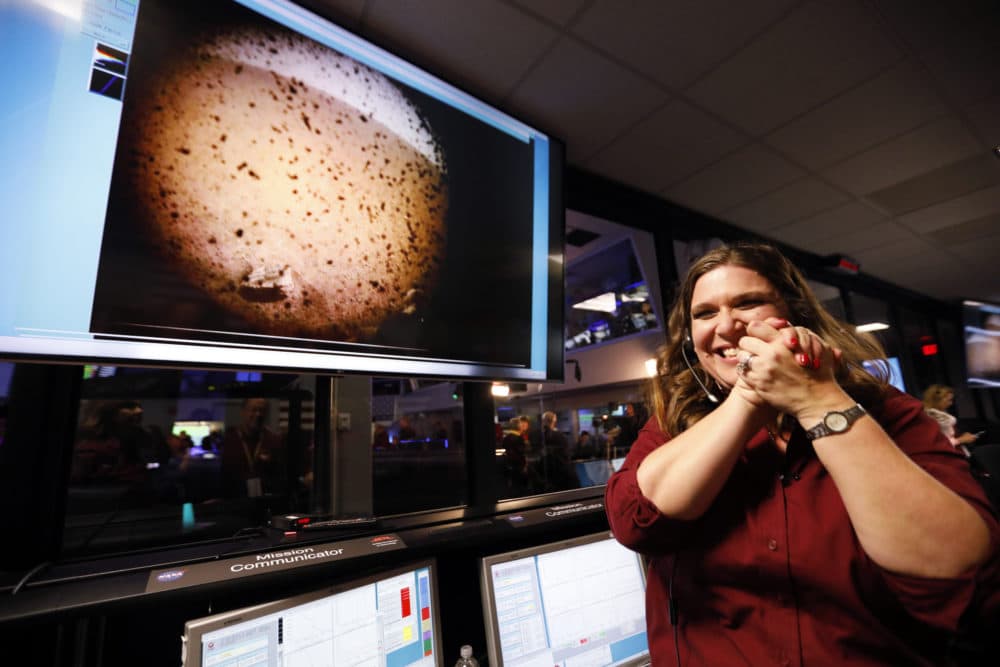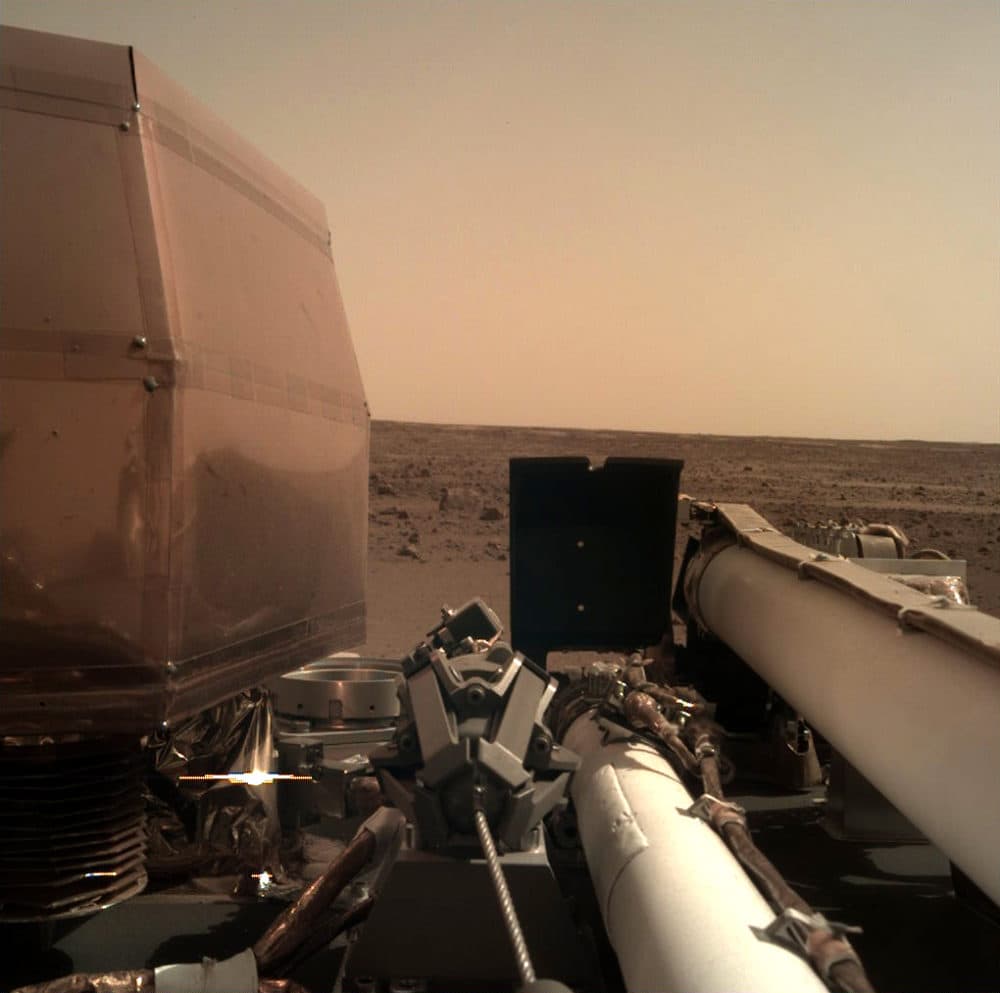Advertisement
View From The Top
After Hurtling Through Space For 6 Months, NASA's InSight Makes Landing On Mars

After a six-month journey hurtling through space, NASA's InSight spacecraft landed on Mars on Monday to cheers and applause inside mission control at the Jet Propulsion Laboratory in California.
“I'm still walking on air,” Bruce Banerdt, the project's principal investigator, tells Here & Now’s Jeremy Hobson a day after the landing.
InSight, which has already started sending back photos from the red planet, is “the first mission to go to Mars to try to probe deep into the planet and understand the structure of the interior,” says Banerdt, “the size of the core, the thickness of the crust, the composition of the inside.”
The missions before InSight looked at the geology, surface chemistry and atmosphere of Mars, but nothing deeper, says Banerdt.
“We know a lot about Mars' surface now, but we know very, very little about the deep inside of Mars,” he says. “This is actually really critical to understanding the history of the planet and the reasons why the surface looks the way it does today.”
Interview Highlights
On his emotions during InSight’s landing and the preparation behind it
“I was pretty, pretty nervous. I thought as I was coming up this week that I was handling it pretty well, but by a few minutes before landing, I was pretty much a basket case.
“We land on rockets, so there is software on board that controls the rockets and keeps the balance such that it's upright. Of course, what we have to make sure is that you don't land on a surface that has a big rock under one leg that might flip you over, and so we've spent a lot of time picking out a region on Mars ... that was pretty big, that didn't have very many rocks — maybe only a tenth of a percent of the area had big rocks on it — and so, statistically, we were in pretty good shape, but you can always have a bad day when you're working with statistics, so we were still pretty nervous."
"We can actually use Mars as kind of a time machine to go back and look at how things were on the planets very soon after they were first formed."
Bruce Banerdt
On whether there is a way to get InSight up and running again if it falls over
“No there's not. I mean, this is this is not a rover mission, it's not a spacecraft that's built to move itself around on the ground — it's built to be a stationary scientific station as soon as it touches down. And so, basically, wherever we are we stick it, that's where we're going to stay.”
On what NASA hopes to discover through the mission
“Mars is kind of a unique laboratory for us — a planetary laboratory — in that it's gone through all the very initial processes of planetary formation, back 4 1/2 billion years ago. But then just a few tens of millions of years after it formed, it slowed way down. So the structures that were set up way back then are still in place — the crust that was put in place when it was first formed, the structure of the mantle and so forth. So we can actually use Mars as kind of a time machine to go back and look at how things were on the planets very soon after they were first formed, and there's some very key processes that determine which way a planet is going to go, whether it goes to a planet with a thick atmosphere and an ocean, or it goes to a very dry planet with a thin atmosphere, or a planet with a super thick atmosphere like Venus, which is extremely hot and sulfurous.
Advertisement
“These differences among the planets we think are due to very subtle changes, very subtle differences in the way they formed early on, and we want to be able to understand those processes. And Mars is a great place to go and start to study that.”

On how the probe will be monitoring for "marsquakes" — earthquakes on Mars
“The thing about marsquakes is that they send waves through the planet, vibrational waves or so-called seismic waves, and as those waves pass through the planet, they get affected by the materials that they travel through. When we sense them at the surface after they've gone down into the plant and come back up to the surface on the other side, we can actually take those wiggles that you see on the [seismometers] from earthquakes on the earth, and we can analyze the shapes of those wiggles — their frequencies, the timing of when they arrive — and put together an actual 3D view of the material that it passed through. … We can actually get a 3D map of the inside of the planet. I like to think of of a quake being like a flashbulb that goes off, and it illuminates the inside of the planet, and the seismometers are our eyes that allow us to start to see the structure deep inside a planet.”
"It's important to understand how Earth got to be the way it is and understand how how stable is the environment that we're living in and how are we likely to be able to affect it."
Bruce Banerdt
On how the InSight mission has changed since it started a decade ago
“The mission that we conceived about nine or 10 years ago is very close to the one that we're flying today. Some of the details have changed — the way we've actually implemented the connection of the seismometer to the spacecraft and some of the shielding techniques and things like that — but the mission itself has been pretty constant.”
On how close InSight is to the Curiosity rover on the planet
“ ... about two or three-hundred miles away. We are just about due north of Curiosity, which actually makes it a little bit of a traffic jam on Mars in the sense that the data that we bring back from the surface of Mars is relayed through basically telecommunication orbiters. So when an orbiter goes overhead, we beam our information up to the orbiter, and the orbiter has a stronger radio that can then beam it back to earth. Those spacecrafts generally go in a north-south orbit, so when an orbiter is going over InSight, it's also going over Curiosity on the same orbit. And so, we have to put together sort of a sharing process, that sometimes Curiosity gets the orbiter and sometimes we get the orbiter, and we have to share the data stream coming back.”
On why it is so important to study Mars
“It's an exciting place. It's a different place, and in terms of exploring new places and new things, it's a very tempting target. But also, as I was saying before, it tells us a lot about how planets form, and then we can apply that back to our own planet [to] understand why we have a planet, why we have a planet that has oceans, why we have a planet that has a breathable atmosphere and a temperature which is conducive to life. It's not a foregone conclusion that you can get a planet that way. I think it's important to understand how Earth got to be the way it is and understand how how stable is the environment that we're living in and how are we likely to be able to affect it in the future.”
On when he anticipates people will be able to step foot on Mars
“I believe — and this is just purely speculation — but just my gut feeling is ... maybe in 20 years, 25 years, we could have people walking on Mars. If we decide that that's something important and something that we want to do, I know the technology exists, and I think we could do it. ... I hope to be around to see that.”
Chris Bentley produced and edited this interview for broadcast. Jackson Cote adapted it for the web.
This segment aired on November 27, 2018.

